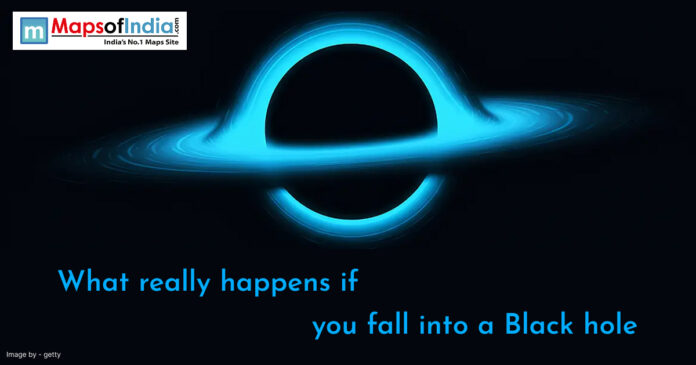Within the range of decades, black holes attracted the attention of scientists and storytellers. These elusive cosmic beings challenge our perception of physics, space and time. They are frightening and majestic: zones in space so dense and powerful that light cannot escape them. However, although all these questions are interesting at one level, one question that arouses more curiosity than others is this: So what exactly happens when you fall into a black hole?
This is one mind-bending journey to find out what is there on the other side of one of the most mysterious entities in the universe.
First, What Is a Black Hole?
A black hole happens after a large star breaks up due to its weight as it nears its demise. The star is squeezed into an infinitely small, tight point termed a singularity, with the surrounding area being referred to as the event horizon. This border is the border of no coming back, when something goes further than there, it cannot go back.
Black holes are of different sizes. Some of them are as narrow as a few kilometres, whereas some supermassive black holes that give their mass to galaxies are millions of times larger or even billions of times larger than our Sun.
The Journey Toward the Black Hole
Suppose you are in a spaceship and floating away at a safe distance from a black hole. It can seem innocent at a distance, nothing wrong with it, a black sphere in the sky, nothing special. However, as you begin to come in close then the forces of gravity will start increasingly leapfrogging.
Initially, you would undergo what is described as gravitational time dilation, based on Einstein’s theory of general relativity. You start experiencing time running slower than a person far away from the black hole. To someone who is far away, you will seem to fall into the black hole in infinite duration, as you will gradually slacken towards the event horizon.
As far as you were concerned, time would appear normal. You would still fall towards the event horizon, encountering more and stranger conditions moving ever closer to it.
Spaghettification: Being Stretched by Gravity
Spaghettification is one of the most frightening and oddly titled phenomena related to black holes. This happens due to the severe gravity gradient close to the event horizon, that is, there is intense gravity at your feet as compared to your head (when you are falling with your feet first).
This would mean your body would begin to stretch both up and down, and squish side to side, and you would have converted into a strand of spaghetti. Not only is this painful, but this is fatal. The tidal forces would tear you into the tiniest bits before you had even gotten close to the singularity.
The strength of spaghettification relies on the black hole size. In case you are falling into a smaller black hole, tidal forces are fatal much earlier than you approach the event horizon. However, in a supermassive black hole, the forces may not be sensed until you have passed the event horizon. You are technically allowed to cross that line without feeling anything at the moment, yet your destiny is cut and dry.
Crossing the Event Horizon
The event horizon is the space around the centre of a black hole from which nothing can make it out, including light. When you reach this point, you can physically do nothing to escape.
An outside observer would witness you, at the event horizon, freeze to vanish gradually, by your light being redshifted (increasing in longer wavelengths) and finally out of sight. However, in your perception, you would cross the point of no return in real time, without perceiving any difference at that stage, assuming that it is a large black hole.
Within the event horizon, there is no longer a defined physics in the sense that we understand it. In some sense, space and time invert in the sense that time can only go forward towards the singularity, and there is no back or lateral movement. Towards the centre, you are being irresistibly drawn.
What Lies at the Singularity?
The singularity is the heart of the black hole, where there exists a point that is infinitely compact and where the laws of physics, as we know them, will fail. As general relativity suggests, all which enters a black hole is sent here. That is where it becomes tricky.
It is a proposal by quantum mechanics that information (e.g. those particles that constitute your body) cannot be destroyed. However, general relativity gives the event horizon that anything going through it is irreversibly lost. This paradox has resulted in what physicists refer to as the black hole information paradox.
Nobody has any idea about what occurs at the singularity. Are the particles which compose your body in compressed form or radiation? Is it information that is saved or information that is lost? Is it possible that there is a wormhole or a bridge to the other section of the universe, or maybe to another universe altogether?
All these questions have not been answered yet and divide the current frontier of theoretical physics.
Could You Survive?
No, at least not in the old-fashioned sense of that word.
In the case of a small or medium-sized black hole, tidal effects would rip you into shreds before you even passed the event horizon. In the case of larger ones, it may be possible that you could pass the horizon in one piece, but soon enough you would end up being spaghettified as you are sucked into the singularity.
Yet a handful of researchers have speculated in the interest of science fiction (and the possibilities of theory) on hypothetical naked singularities (singularities with no event horizon) or more stable wormholes. These are just speculations about things and are never substantiated, yet they fuel the imagination and studies.
Could Black Holes Be Portals?
Among the most promising theories in contemporary astrophysics is the one according to which black holes might not just be a portal to other parts of space, but also another dimension. Part of the solutions to Einstein equations implies that what could appear is a rotating black hole linked to a white hole-a fictional reverse time equivalent of a black hole that vomits matter rather than sucks it in.
This may give rise to what is called the Einstein-Rosen Bridge, or simply say, a wormhole. However, to cross such a bridge would require unusual circumstances, such as negative energy or other matter to stabilize it that we do not yet know about or have.
Once more, this is a theoretical position. To date, wormholes or white holes cannot be supported by any experimental evidence. However, it is the possibility of such things that makes the black holes so interesting to consider mathematically.
Final Thoughts
Once in a black hole, there is no coming out; it is a one-way journey, and it is destruction as far as science is now concerned. Black holes are one of the biggest mysteries of the universe due to their immense gravity, the twisting of space-time, and the unidentified singularity.
But research on the topic of black holes extends the horizon capabilities within human knowledge. They break the oldest physics laws, they provide valuable information about time and space, and maybe even speak volumes about the universe itself.
To conclude, therefore, though a person is not expected to go into a black hole in the near future, one thing that has been posing one puzzle or another to our knowledge is the question of what will happen to you should you somehow find yourself in one.





